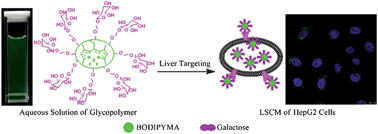Water-soluble BODIPY-conjugated glycopolymers as fluorescent probes for live cell imaging†
Abstract
Fluorescent probes have attracted ongoing attention in early detection of tumor cells. The development of novel fluorescent materials with high cellular internalization efficiency, good photostability, and high specificity for tumor cells is in urgent demand. Herein, a highly water-soluble, multivalent and highly specific BODIPY-conjugated glycopolymer was synthesized by Atom Transfer Radical Polymerization (ATRP) for direct tumor cell imaging, which showed good photostability. The fluorescence quantum yield of a BODIPY-conjugated glycopolymer increased to 0.52 compared with 0.31 of BODIPYMA due to the introduction of galactose. The cell viability of BODIPY-conjugated glycopolymers against HepG2 and NIH3T3 cells was more than 80%, indicating that the glycopolymers have low cytotoxicity to living cells. Moreover, simple incubation of living cells with a BODIPY-conjugated glycopolymer led to efficient internalization into HepG2 and clear visualization in cytoplasm, due to the high brightness of BODIPY and good specificity between HepG2 and galactose as compared to NIH3T3 cells. These results suggest that BODIPY-conjugated glycopolymers have potential use as fluorescent probes in live cell imaging. Further fine-tuning the fluorescent property and targeting ability of BODIPY-conjugated glycopolymers can lead to more complicated imaging applications and subcellular target detection.


 Please wait while we load your content...
Please wait while we load your content...